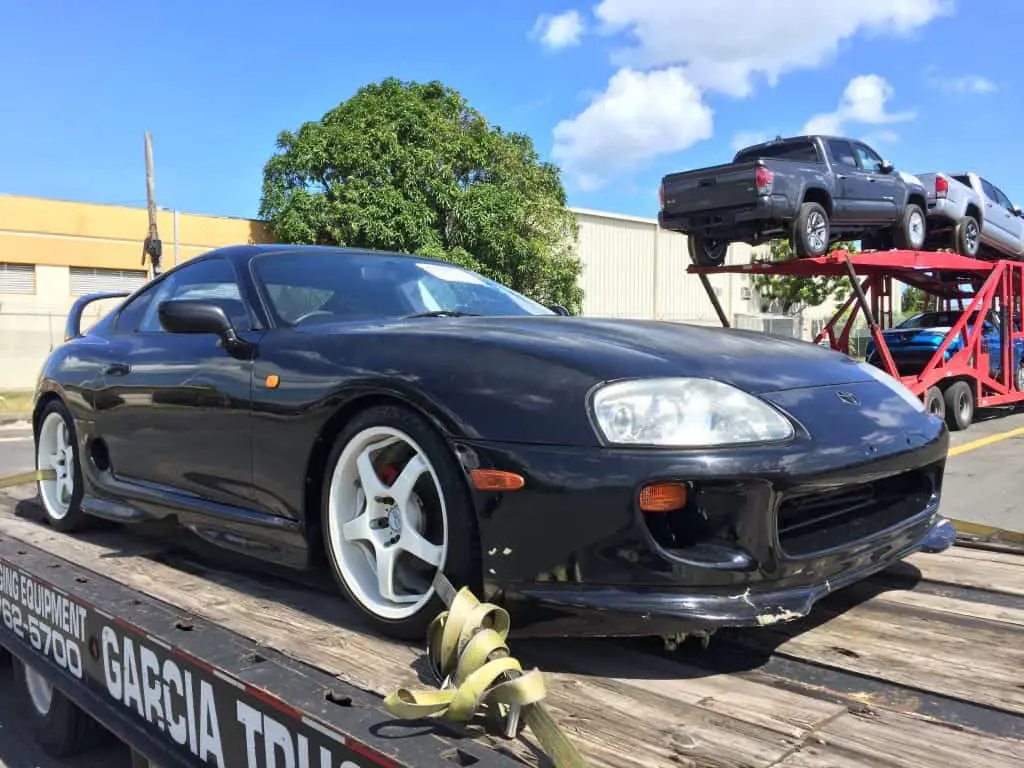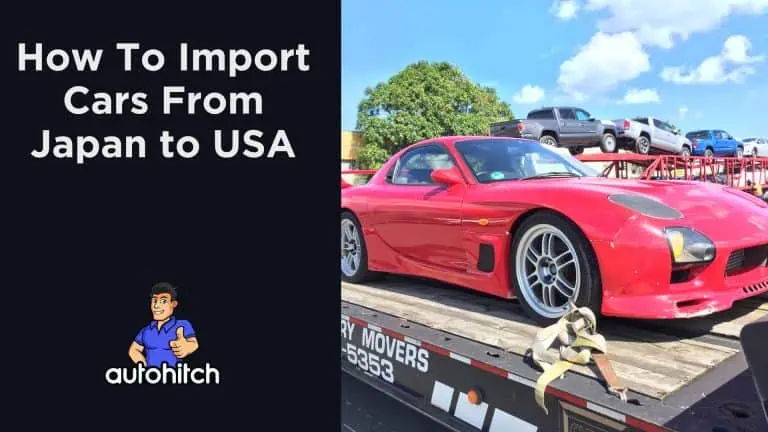Have you ever dreamed of owning a high-performance car from Japan like the Nissan Skyline GT-R or Toyota Supra?
So did I, and after purchasing a 1993 Toyota Supra and 1995 Mazda RX-7 in 2016, I had to quickly figure out how to get these cars into the U.S. and in a way that they would be street legal.
Using my own personal experience and some additional extensive research, I created the article below to make you an expert on how to import cars from Japan, without all the pitfalls and delays I experienced.
I’ll walk through the step-by-step process, requirements, costs, and paperwork needed to successfully get any car from Japan to the USA.
Table of Contents
Can I Legally Bring Japanese Cars To The United States?
First, the good news – it is possible to legally import Japanese domestic market (JDM) vehicles under certain conditions:
- Cars over 25 years old can be imported freely under the “25 year rule.”
- Some newer models like GT-Rs can qualify under Show or Display exemptions.
- Temporary import exemptions allow driving for up to 12 months.
Unfortunately for me, it was 2016 when I was trying to import my Supra and RX-7, so they weren’t over 25 years old yet. This forced me to send them to Canada, where I had to rent storage facilities and park them until they were 25 years old.

Important: You must verify the legality, confirm EPA/DOT compliance or exemptions, and prepare proper ownership documentation BEFORE THE VEHICLES ARRIVE AT A PORT OF ENTRY! If your paperwork is incorrect the U.S. govt is not required to let you correct the errors or send the car back. They can immediately seize them and place them into an auction!
Exemptions Allowing Import Of Non-Compliant Vehicles
Based on the search results, there are a few key exemptions that allow imported cars that are not originally street-legal in the U.S. to become legal to drive:
- 25 Year Rule Exemption: Vehicles that are 25 years old or older are exempt from EPA and DOT standards, so they can be imported and made street legal without modifications.
- Show and Display Exemption: Rare, historically significant vehicles can get NHTSA approval to be imported for show/display purposes with limited on-road use of 2,500 miles per year.
- Racing Exemption: Vehicles intended solely for racing and not regular driving do not have to meet DOT/EPA standards and can get exemptions for import.
- Testing Exemption: Manufacturers and developers can temporarily import test vehicles with EPA approval.
- Alteration or Repair Exemption: Non-compliant vehicles can be temporarily imported to be modified and certified by an EPA Independent Commercial Importer.
So, in summary, the 25-year rule and show/display exemptions from DOT/EPA requirements are the main ways an imported vehicle that was not originally street legal can eventually become street legal and driven regularly in the U.S., within certain mileage limits.
Racing, testing, and repair exemptions provide more limited street legality.

Step-By-Step Guide To Importing Cars From Japan
Follow this 10 step checklist for importing a car from Japan to ensure you handle all vehicle regulations and import requirements:
| # | Import Checklist |
|---|---|
| 1 | Choose the Right Car: Verify it meets import eligibility rules based on age or exemptions. |
| 2 | Find a Supplier: Use an auction site or export dealer to source quality vehicles for import. |
| 3 | Validate Ownership Documents: Get the vehicle title, export certificate, and other proofs to satisfy U.S. Customs. |
| 4 | Select a Shipping Method: Book RoRo or any other shipping container transport |
| 5 | File Importer Security Filing: Submit ISF form to CBP 24 hours before vehicle loading. |
| 6 | Prepare Customs Forms: Fill out EPA 3520-1, DOT HS-7 declaration, and Entry Summary 7501 forms. |
| 7 | Clear Customs & Inspections: Present ownership documents and pay any applicable import duties. |
| 8 | Review Gas Guzzler Tax: cars with low MPG may incur this federal excise tax. |
| 9 | Choose Clearance Type: Decide between DIY informal entry or formal entry with an import broker based on your situation. |
| 10 | Register With DMV + Get Plates: With import docs complete, finish by titling the car in your state to drive legally! |
Pro Tip: Work with a Registered Importer or a Broker to simplify dealing with technical DOT/EPA regulations in Steps 3 to 6. This is what I did because believe me: It’s a massive headache doing it yourself!
What Does It Cost To Import A Car From Japan?
Importing from Japan involves various shipping expenses, taxes, and regulatory fees. Ballpark costs to budget for:
- Car Purchase Price: Auction values or retail prices in Japan
- Export and Shipping: $2,000+ for shipment transit
- Duty: 2.5% import duty on vehicle value
- Other Import Fees: Expect to pay $500+ in processing charges
- DOT/EPA Modifications (if non-compliant): Can be thousands for some models
With procurement, ocean freight, and import costs, plan on a minimum $5,000 total budget to import a car from Japan. Sports models can reach $10k or higher.
(Shipping costs are estimated based on shipment directly from Japan to the USA)
Import Broker & Agent Fees
Based on the search results, import agents or brokers typically charge fees in the range of $50 to $175 for basic customs clearance services per shipment. Additional charges may apply for extra services like bonds, security filings, classifications, and paying duties/taxes.
- The basic customs entry filing fee is often $125-$175 per shipment
- Import Security Filing (ISF) costs $25-$55 per shipment
- Single entry bonds cost ~$2 per $1000 value (min $40) + $35 prep fee
- Continuous bonds cost $450+ per $50k value covered
- Additional fees per services like classifications, invoices, PGAs
So for a sample shipment:
- Entry filing: $125
- ISF: $35
- Classifications: $15
- Total: $175
Large volume importers can often negotiate discounted rates. But small shipments under $1000 value tend to pay higher fees proportional to shipment value.
Popular Japanese Cars For Import
Based on the search results, some of the most popular cars imported from Japan to the US include:
- Nissan Skyline GT-R (R32, R33, R34) – Legendary high performance sports car known for racing pedigree. Popular for tuning potential.
- Toyota Supra (A70, A80) – Iconic Japanese sports car praised for styling and smooth inline 6-cylinder turbo engine.
- Mazda RX-7 (FD) – Rotary-engine sports car acclaimed for lightweight chassis and handling capabilities.
- Honda Civic Type R (EK9) – High revving VTEC engines make these popular for imports and tuning.
- Toyota MR2 (SW20) – Mid-engine Toyota sports car with smooth naturally aspirated engines and excellent balance.
- Nissan Silvia (S13, S14, S15) – Mainstay of drift culture and tuning scene with potent turbocharged engines.
- Mitsubishi Lancer Evolution (IV-IX) – Rally-bred all wheel drive performance sedans with massive tuning potential.
The Nissan Skyline GT-R and Toyota Supra in particular have become extremely desirable modern classic imports from Japan. Prices have risen sharply for clean examples over the past decade. Many enthusiasts import these for nostalgia or investment purposes.
Importing JDM Cars – Common FAQs
We know importing a rare sportscar from overseas involves lots of questions. Here are answers to some frequently asked questions:
How long does it take to ship a car from Japan?
Ocean shipping time is approximately 8-10 weeks. With both ends, expect the total process to take 3-4 months.
What are import restrictions on JDM cars?
Vehicles must be over 25 years old OR have a specific DOT/EPA exemption to be legally imported without modifications.
Can I drive the Japanese import car immediately?
After clearing customs you can drive the car. But register it with your DMV and get U.S. plates before regular use.
Do I need an importer license?
No special license needed! Retain an import broker if you don’t want to handle DOT/EPA paperwork personally.
There is no doubt that importing a car from Japan is complex and has all sorts of legal pitfalls you can easily drop right into without doing everything perfectly.
My Closing Thoughts
This is why I will end my article by recommending again that you use an import agent or an import broker to handle the process for you. Yes, it does cost more money, but if you decide to handle everything yourself, you risk Customs Seizing your car and losing your entire investment.
Sources For This Article
- https://www.reddit.com/r/cars/comments/2gtns4/true_cost_to_import_a_car_from_japan/
- https://www.sdcinternationalshipping.com/import-car-from-japan/
- https://usacustomsclearance.com/process/how-much-does-a-customs-broker-cost/
- https://www.cbp.gov/trade/basic-import-export/importing-car
- https://www.epa.gov/importing-vehicles-and-engines/learn-about-importing-vehicles-and-engines
- https://www.dirtlegal.com/blog/the-show-and-display-rule-which-cars-qualify-and-which-cars-dont
- https://carused.jp/blog/popular-japanese-used-cars-and-jdm-that-are-importable-to-the-us/
- https://grassrootsmotorsports.com/forum/grm/learn-me-importing-japanese-vehicle-over-25-yrs/66199/page1/
- https://www.reddit.com/r/cars/comments/6b1yli/importing_a_car_from_japan_to_us/
My Personal Experienced Used To Create this Article:
In 2016 I purchased a 1993 Toyota Supra and a 1995 Mazda RX-7 from the U.S. Govt at auction in Puerto Rico. The vehicles had been seized from someone who imported them from Germany but did not follow the law, so Customs seized the vehicles and auctioned them off. I had to transport the cars to the port in San Juan on a Flatbed because the cars could not touch U.S. soil by law. From there they went to New Jersey where they again had to be transported on a flatbed to Canada. Once in Canada they were stored until they turned 25 years old and became exempt under EPA laws.



